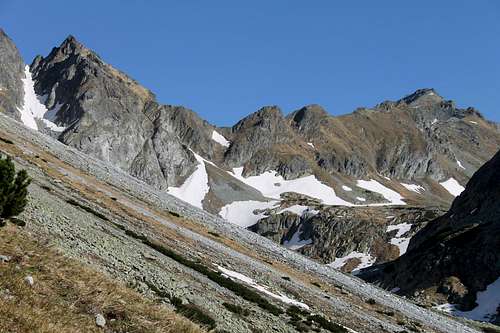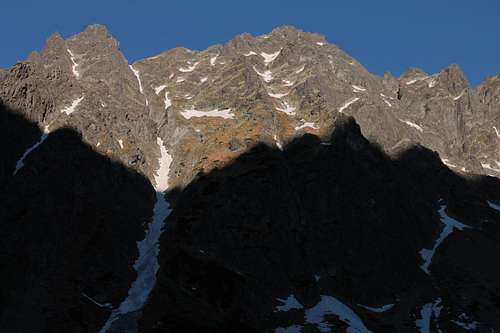|
|
Mountain/Rock |
|---|---|
|
|
49.16326°N / 20.05172°E |
|
|
Hiking, Mountaineering, Mixed, Skiing |
|
|
Spring, Summer, Fall, Winter |
|
|
7946 ft / 2422 m |
|
|
Overview
In this section I want to describe missing piece from the collection of Tatra’s ridges. The whole ridge is most often called Hrebeň Bášt (Bastions ridge), named after few summits with such a name. For SP purposes I defined it as a ridge beginning in Nižné Koprovské sedlo and ending in Patria. Officially it begins in Hlinská veža, and more accurately in Baštové sedlo and its length is about 4 km.The first crossing of this ridge in the section Patria-Satanovo sedlo by Jan G. Pawlikowski with a guide, Maciej Sieczka in summer 1880. Section Satanovo sedlo – Hlinská veža was crossed by Gunther O. Dyhrenfurth and Hermann Rumpelt in 1907.
The highest point of this ridge is Satan (2422 m). Slopes falling down to Mlynická dolina are very gentle, suitable for skiing in winter, whereas faces falling to Mengusovská dolina are very steep, up to 500 m high, very popular especially in winter, but with rock of very bad quality (rotten). The most popular winter route is Červený žľab couloir between Predná Bašta and Satan, which is also a fine area for extreme skiing.
I choose Nižné Koprovské sedlo (2120 m) as a starting point of the ridge, since it’s the lowest point in the ridge connecting Koprovský štít (2363 m) with Hrebeň Bášt. It’s separating Koprovská veža (2250 m) from Koprovský chrbát and used to be a very popular pass, until 1886, when it was replaced by a higher located Vyšné Koprovské sedlo (2180 m).
The first summit in this ridge, Koprovská veža (2250 m) is small but distinctive rocky tower, first climbed in 1906 by Gunther O. Dyhrenfurth and Hermann Rumpelt. It’s easily accessible from Nižné Koprovské sedlo (20 min, I UIAA) or Hlinské sedlo (1/4 h, I UIAA).Hlinské sedlo is a narrow pass between Koprovská veža and next summit in this ridge, Hlinská veža (2334 m). Mlynické sedlo is separating it from Štrbský štít (2385 m). Hlinská veža is accessible for climbers from Hlinské sedlo (II-III UIAA, 1 ½ h), or from Mlynické sedlo (1/2 h, I UIAA, the same goes for Baštové sedlo). First ascent: Ernst Dubke, Hans Wirth, Johann Franz senior (guide), 9.7.1905.
North face of Hlinská veža is 300 m high, suitable particularly for winter climbing (grades II-VI UIAA).Topos here.
The ridge continues via Baštové sedlo to Veľká Capia veža.This tower has two summits, southern and northern, separated by Vyšná Capia štrbina. Interesting for climbers is particularly its eastern face, 350 m high (II-VI UIAA) and NE face, 250 m high. Capia veža was first climbed by Zygmunt Klemensiewicz and Jerzy Maślanka, 23.8.1905.
Capia štrbina is separating Veľká Capia veža from Malá Capia veža. Malá Capia veža is small but distinctive tower in the ridge, its eastern face creates one big wall together with the E face of its higher sister. Vyšné Baštové sedlo is linking Capie veže with northern summit of Zadná Bašta. Zadná Bašta (2380 m) is the most distinctive peak in the whole ridge, with impressive eastern face (300-500 m, III-VI UIAA) and three summits (northern, central and the highest one, southern).Topos for E and NE face here.
Diablovo sedlo is separating Zadná Bašta from Zlatinská veža, with 150 m high eastern face, which is a part of Diablovina massif, consisting of Zlatinská veža, Diablovina (2390 m), Pekelník (2374 m) and Čertov hrb.
Via Satanovo sedlo (2300 m) our ridge culminates in Satan (2422 m), the highest point of Hrebeň Bášt. There is a nice winter route leading to Satanovo sedlo via Satanov žľab couloir.More about Satan here.
Interesting for climbers, especially for winter climbing, is its 450 m high NE face. The last 200 m creates so called Satanova galéria.Topos here.
By climbing Satanova vežička we reach Sedlo nad Červeným žľabom, from which falls the famous Červený žľab couloir to Mengusovská dolina (very popular winter route). More info and photos here.On the opposite side of this saddle, there is Predná Bašta (2366 m), easily accessible from the above mentioned saddle.
Sedlo nad Širokým žľabom (2199 m) is separating it from the last summit with Bašta in its name – Malá Bašta (2289 m). The ridge, which was rocky at the beginning, is loosing its sharpness, and from Predná Bašta it changes into mixed rocky and grassy slopes. The last true summit of this ridge is Patria (2203 m), towering above Štrbské pleso, known for the nice tower on its slopes – Ihla v Patrii.











